Page 6 of 290
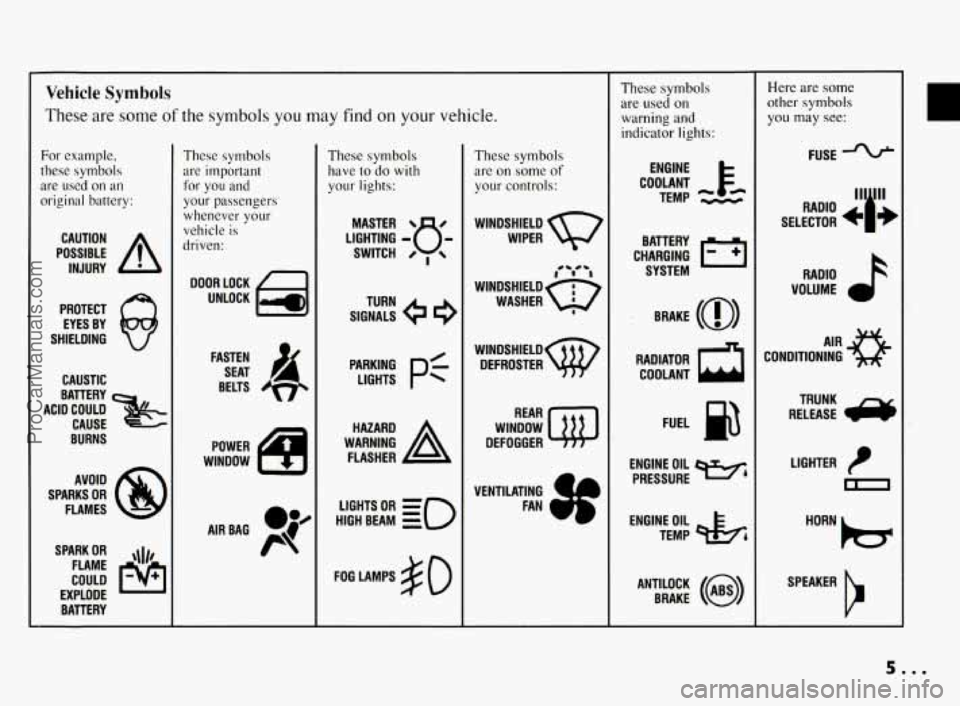
Vehicle Symbols
These are some of the symbols you may find on your vehicle.
For example,
these symbols
are used on an
original battery:
POSSIBLE A
CAUTION
INJURY
PROTECT EYES BY
SHIELDING
CAUSTIC
ACID COULD BATTERY
CAUSE
BURNS
AVOID
SPARKS
OR
FLAMES
SPARK
OR ,111,
COULD FLAME
EXPLODE BATTERY
These symbols
are important
for you and
your passengers
whenever your
vehicle
is
driven:
DOOR LOCK
UNLOCK
FASTEN SEAT
4
BELTS
POWER
WINDOW
'* -- I
These symbols
have to do with
your lights:
SIGNALS e
TURN
HIGH BEAM
OR = =o
FOG LAMPS $0
These symbols
are
on some of
your controls:
WIPER Q7
WINDSHIELD
DEFROSTER
WINDOW
DEFOGGER
VENTILATING
4
FAN (I
These symbols
are used
on
warning and
indicator lights:
COOLANT Fa
TEMP --
ENGINE
CHARGING
I-1
BATTERY SYSTEM
BRAKE
(0)
RADIATOR COOLANT
FUEL
ENGINE OIL
PRESSURE
Wb
TEMP OIL ?b
ANTILOCK (@)
BRAKE
Here are some
other symbols
you may see:
FUSE
11lp RADIO , - -
SELECTOR b I JE
RADIO
VOLUME
CONDITIONING
AIR 43
LIGHTER
m
SPEAKER
b
5.00
ProCarManuals.com
Page 56 of 290
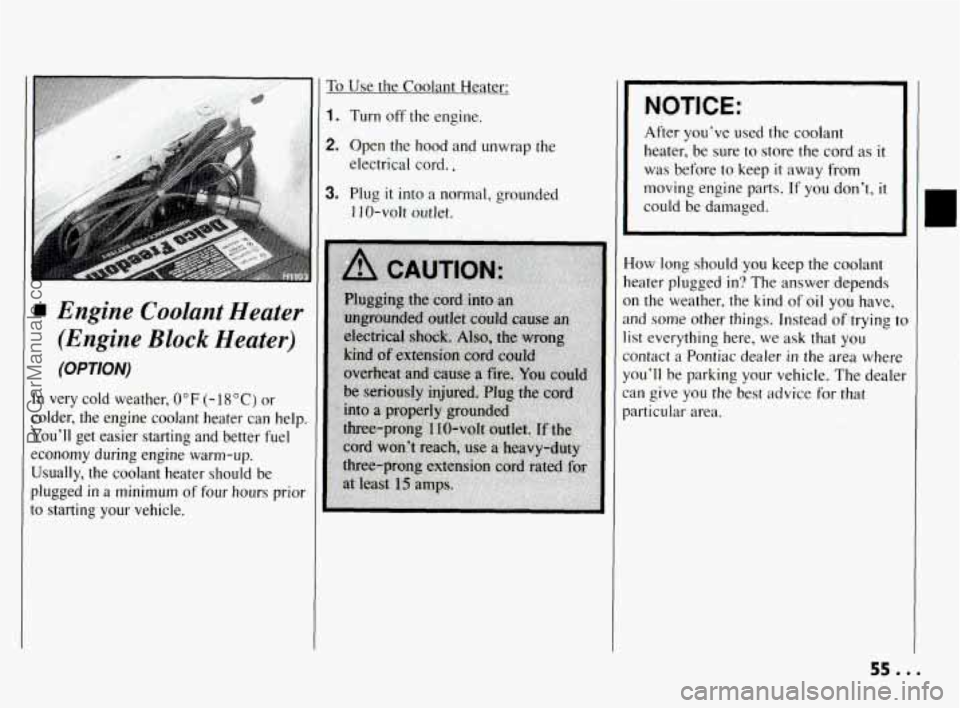
1 Engine Coolant Heater (Engine Block Heater)
(OPTION)
In very cold weather, 0" F (- 18 O C) or
colder, the engine coolant heater can help.
You'll get easier starting and better fuel
economy during engine warm-up.
Usually, the coolant heater should be
plugged
in a minimum of four hours prior
to starting your vehicle.
To Use the Coolant Heater:
1. Turn off the engine.
2. Open the hood and unwrap the
electrical cord.,
3. Plug it into a normal, grounded
110-volt outlet.
NOTICE:
After you've used the coolant
heater, be sure
to store the cord as it
was before to keep
it away from
moving engine parts. If
you don't, it
could be damaged.
How long should you keep the coolant
heater plugged in? The answer depends
on the weather, the kind of oil you have,
and
some other things. Instead of trying to
list everything here, we ask that you
contact a Pontiac dealer in the area where
you'll be parking your vehicle. The dealer
can give
you the best advice for that
particular area.
55.D.
ProCarManuals.com
Page 93 of 290
Features & Controls
SYSTEMS MONITOR
0
(-J[=zFz]
[HeURlTY][-))
Warning Lights (CONT.)
I
I-] INFORMATION DRIVER
CHECK OIL LEVEL - LAMP
WASHER FLUID
CHECK QAQES LOW
COOLANT
moo DOOR TRUNK AJAR TURN SIONAL
BACK UP TAIL
BRAKE LAMP
MILES TRIP
(][TEiir] ENGINE SOON
[E][--
Engine Coolant Temperature Warning
Light
This light tells you that your engine
coolant has overheated or your radiator
cooling fans are not working.
If you have
been operating your vehicle under normal
driving conditions, you
should pull off the
road, stop your vehicle and
turn the
engine off as soon as possible.
I #..92
ProCarManuals.com
Page 94 of 290
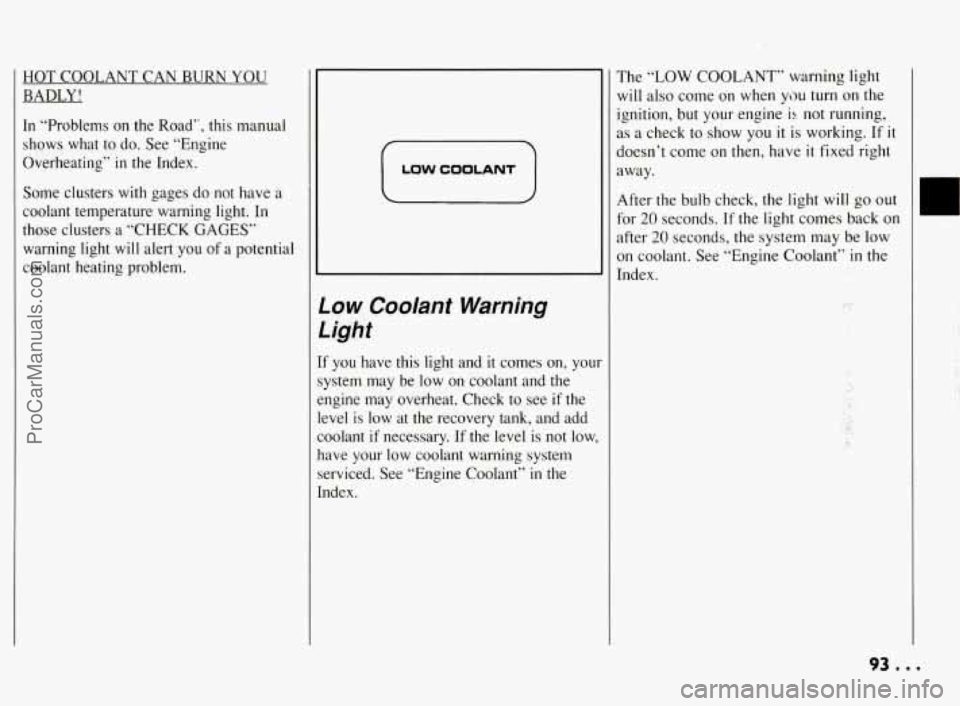
HOT COOLANT CAN BURN YOU
BADLY!
In “Problems on the Road”, this manual
shows
what to do. See “Engine
Overheating”
in the Index.
Some clusters
with gages do not have a
coolant temperature warning light. In
those clusters a “CHECK GAGES”
warning light
will alert you of a potential
coolant heating problem.
r LOW COOLANT
Low Coolant Warning
Light
If you have this light and it comes on, you
system may be low on coolant and the
engine may overheat. Check to see
if the
level is low
at the recovery tank, and add
coolant
if necessary. If the level is not low.
have your low coolant warning system serviced. See “Engine Coolant”
in the
Index. The
“LOW COOLANT” warning
light
will also come on when you
turn on the
ignition, but your engine
is not running,
as a check to show you
it is working. If it
doesn’t come on then, have it fixed right
away.
After the bulb check, the light will go out
for
20 seconds. If the light comes back on
after
20 seconds, the system may be low
on coolant. See “Engine Coolant” in the
Index.
93.0.
ProCarManuals.com
Page 101 of 290
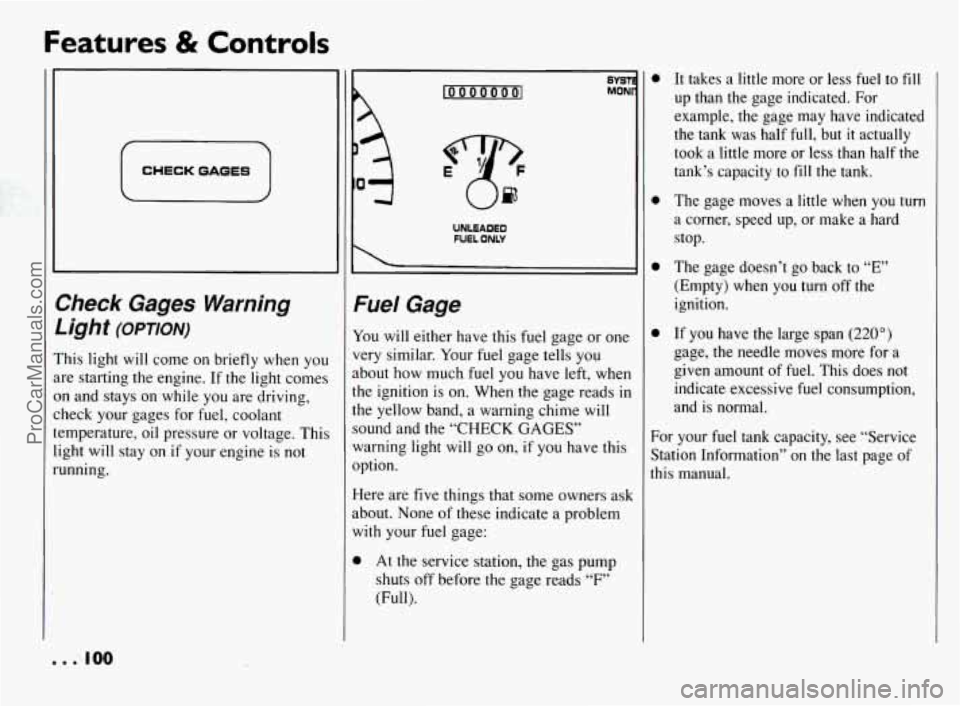
Features & Controls
CHECK GAGES
>heck Gages Warning
Jght
(OPTION)
‘his light will come on briefly when you
re starting the engine. If the light comes
n and stays on while you are driving,
heck your gages for fuel, coolant
:mperature, oil pressure or voltage. This
ght will stay on
if your engine is not
Inning.
loooooool
8YST MONl
UNLEADED
FUEL ONLY
Fuel Gage
You will either have this fuel gage or one
very similar.
Your fuel gage tells you
about how much fuel you have left, when
the ignition is on. When the gage reads in
the yellow band, a warning chime will
sound and the
“CHECK GAGES”
warning light will
go on, if you have this
option.
Here are five things that some owners ask
about. None
of these indicate a problem
with your fuel gage:
0 At the service station, the gas pump
shuts off before the gage reads
“F”
(Full).
It takes a little more or less fuel to fill
up than the gage indicated. For
example, the gage may have indicated
the tank was half full, but
it actually
took a little more or less than half the
tank’s capacity to
fill the tank.
The gage moves a little when you
turn
a corner, speed up, or make a hard
stop.
The gage doesn’t go back to
“E”
(Empty) when you turn off the
ignition.
If you have the large span
(220”)
gage, the needle moves more for a
given amount of fuel. This does not
indicate excessive fuel consumption,
and is normal.
For your fuel tank capacity, see “Service
Station Information” on the last page of
this manual.
.e 100
ProCarManuals.com
Page 102 of 290
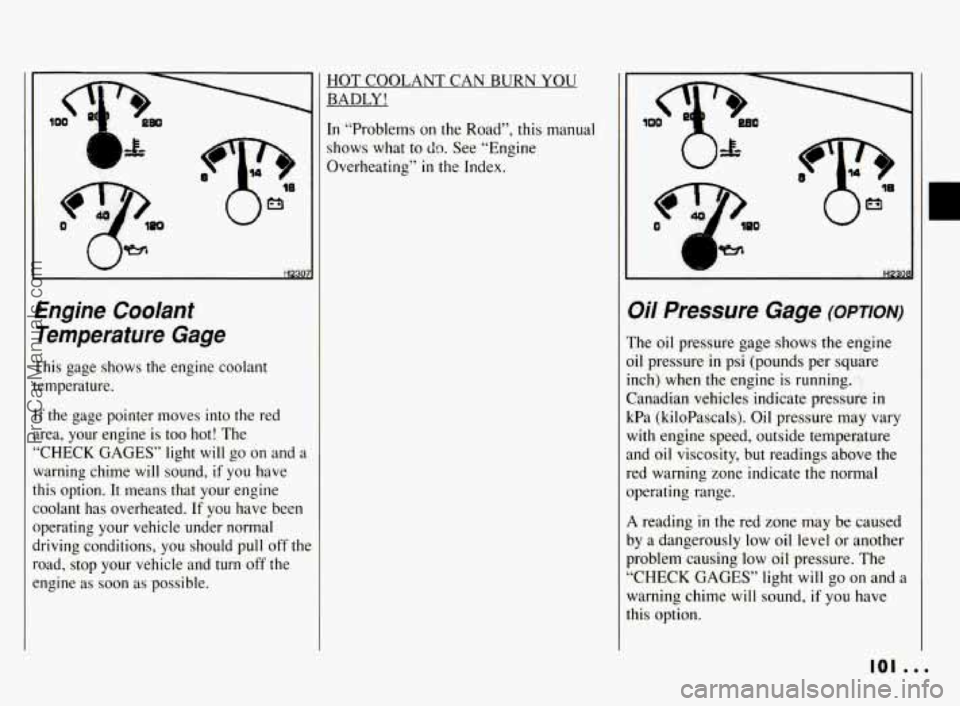
HOTCOOLANTCANBURNYOU BADLY!
In “Problems on the Road”, this manual
shows what to
do. See “Engine
Overheating”
in the Index.
H2a
Engine Coolant
Temperature Gage
This gage shows the engine coolant
temperature.
If the gage pointer moves into the red
area, your engine is too hot! The
“CHECK GAGES” light
will go on and a
warning chime will sound, if you have
this option.
It means that your engine
coolant has overheated.
If you have been
operating your vehicle under normal
driving conditions, you should pull off
thc
road, stop your vehicle and turn off the
engine
as soon as possible.
Oil Pressure Gage (omom-)
The oil pressure gage shows the engine
oil pressure
in psi (pounds per square
inch) when the engine is running.
Canadian vehicles indicate pressure
in
kPa (kiloPascals). Oil pressure may vary
with engine speed, outside temperature
and oil viscosity, but readings above the
red warning zone indicate the normal
operating range.
A reading in the red zone may be caused
by a dangerously
low oil level or another
problem causing low oil pressure. The
“CHECK GAGES” light
will go on and a
warning chime will sound,
if you have
this option.
101 ...
ProCarManuals.com
Page 156 of 290
0
0
Have your Pontiac in good shape for
winter. Be sure your engine coolant
mix is correct.
You may want to put winter
emergency supplies
in your trunk. Include
an ice scraper,
a small brush or
broom, a supply of windshield washer
fluid,
a rag, some winter outer clothing, a
small shovel, a flashlight, a red cloth, and
a couple of reflective warning triangles.
And,
if you will be driving under severe
conditions, include a small bag of sand, a
piece
of old carpet or a couple of burlap
bags to help provide traction. Be sure you
properly secure these items in your
vehicle.
Driving on Snow or Ice
Most of the time, those places where your
tires meet the road probably have good
traction.
However, if there is snow or ice between
your tires and the road, you can have
a
very slippery situation. You’ll have a lot
less traction or “grip” and
will need to be
very careful.
155...
ProCarManuals.com
Page 177 of 290
Problems on the Road
H Engine Overheating
You will find a coolant temperature gage
or a warning light about a hot engine on
your Pontiac’s instrument panel. See
“Coolant Temperature Gage” and
“Coolant Temperature Warning Light” in
the Index.
If Steam Is Coming From
Your Engine
NOTICE:
If your engine catches fire because
you keep driving with no coolant,
your vehicle can be badly damaged.
The costly repairs would not be
covered by your warranty.
ProCarManuals.com